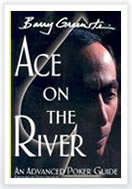 |
Author: Barry Greenstein Publisher: Last Knight Publishing Pages: 328 Pub. Date: 2005 Price: $21.26 |
Book Review: Part 2
Also intentional in this part’s format are two back-to-back chapters about bankroll management. The first chapter is about making money, while the second part is about holding on to it, a skill that the newly-successful poker player may forget about in his excitement. A third chapter talks about one of the most famous bankroll leaks for many otherwise successful players, betting on sports. The poker world is full of anecdotes about players losing their bankroll away from the table, and Greenstein shares just a few in making his point: if you’re playing poker to win money, it’s counterproductive to give it back in a major house-edge game, and if you’re a good poker player, it takes you away from other chances to win at the table.
From there it’s on to other deep-think topics, including protecting one’s self and one’s family from the worst parts of the poker world, understanding the role between poker and sexuality (in which Greenstein takes a commonsense but highly debatable position), and a look at gambling’s role within a productive society. Anti-gambling factions are quick to pounce on all forms of gambling as a leech on society, but Greenstein takes a more measured, philosophical approach, noting both that almost all business is a form on gambling at its core, and that gambling can be an expression of a free society. Greenstein personally has decided on generously giving to charity as compensation for his participation in what is often portrayed as a “nonproductive” profession, and Greenstein’s charitable donations following major tournaments are among his most famous endeavors.
Part 3 of Ace on the Riverveers into strategy at the table. Titled “Advanced Play”, its game-specific topics include: Mathematics of Poker; Game Theory; Chaos; Different Limits; Money Management, Play on the Internet; Play Lessons; Tournaments; Some No-Limit Tournament Hands; and Parting Thoughts. This section is as smoothly written as the rest of the book and includes plenty of helpful pointers, though it can’t help but gloss over a few of the topics in keeping the focus on general matters. Greenstein shares some of his general playing tactics and gives examples of them in key hands, but doesn’t give away the farm. While the topics he brings up are important, readers can find more detailed examinations of them in other books and by other writers, making this third part not as vital as the rest of the book. Still, their presence fleshes out Ace on the Riverto healthy book length, and there’s enough of value in this section to make it well worth the read.
Overall, Ace on the River is a vital read, offering a livable poker philosophy and the whys and hows for playing the game in the modern age. Poker continues to evolve, and it’s players like Barry Greenstein who are most likely to be able to evolve with it. Such is the impact of a future Poker Hall of Famer.